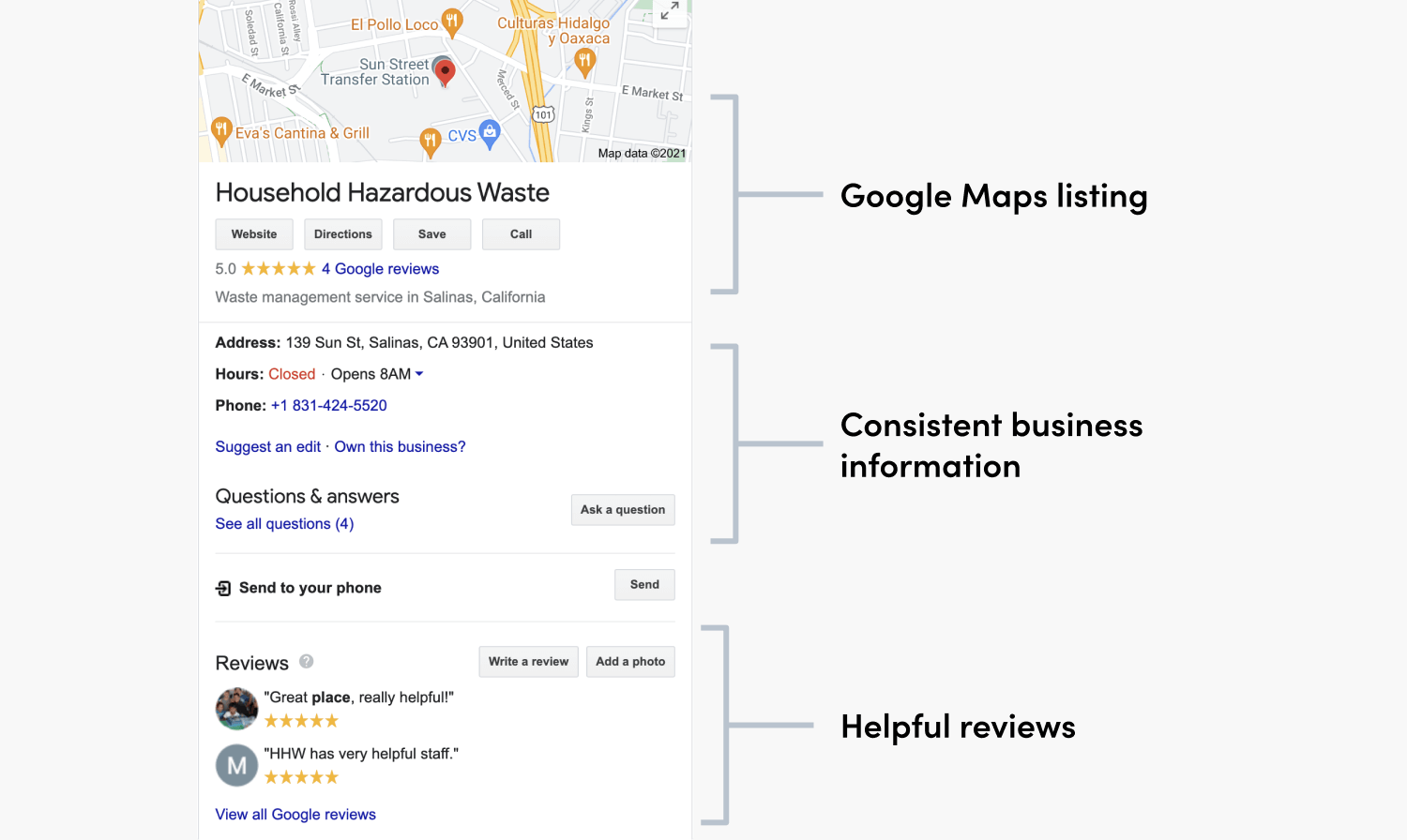How to Start a Waste Collection Business [2024 Guide]

As a $52 billion industry with a 1.4% year-over-year growth rate since 2015, the waste management industry provides a massive opportunity for entrepreneurs and those looking for a scalable side hustle. According to the Environmental Protection Agency, the United States produces over 292 million tons of waste per year (or 4.9lbs/day per American). Additionally, with the economy rebounding after the COVID-19 pandemic, that number is expected to increase.
There hasn’t been a better time to start a waste collection business. Savvy entrepreneurs and ambitious side-hustlers can turn cash into profit with a bit of business know-how and the proper tools and software.
In this article, we’ll cover six essential steps to starting a waste collection business then we will show you how using route optimization software sets you up to expand and scale your business easily.
- Step 1: Choose a Waste Industry Sector
- Step 2: Craft a Simple Business Plan
- Step 3: Register Your Business and Obtain the Proper Permits
- Step 4: Purchase the Necessary Equipment
- Step 5: Advertise Your Waste Collection Business
- Step 6: Plan the Most Efficient Routes for Your Waste Collection Team
Step 1: Choose a Waste Industry Sector
Not all garbage is created equal. The first step in starting a waste management business is to choose what types of waste materials you want to collect and transport.
Different industries require different types of waste management. Some of these industries are:
- Medical: Waste from healthcare facilities, such as nursing facilities, dental offices, hospitals, veterinary clinics, etc.
- Construction: Waste generated from construction sites, often containing hazardous materials such as paint, asbestos, plaster, and other elements that require specialized removal
- Electronic: Discarded electronic devices, such as household appliances, lamps, toys, computers, medical devices, batteries, etc.
- Green: Organic waste that can be composted, such as garden and yard clippings
- Animal/pet: Yard droppings and waste from litter boxes, equestrian or marine facilities, etc.
- Industrial: Material waste from factories, mines, and mills, oftentimes hazardous material requiring specialized removal
- Nuclear: An up and coming industry requiring waste removal from nuclear power facilities
If you’re struggling to decide which industry is right for you, research the waste needs in your local area or the region you plan on doing business.

Step 2: Craft a Simple Business Plan
Every businesses needs to start with a solid business plan. By first sitting down and writing out your goals and plans, you can bypass a lot of the hazy frustration that often accompanies starting a new business. Plus, you’ll have a document you can reference to make sure your business is on track and heading in the right direction as it grows.
Some questions to consider when crafting your business plan:
- What is your business structure (sole proprietorship, partnership, LLC, incorporated)?
- What are the tangible goals and objectives for your waste management business?
- Who is your target customer, and what specific problem are you helping them solve?
- Do you have any competitors in your particular industry? How is your service different or better?
- What does your pricing look like in comparison with other waste collection and management businesses?
- How will you market and grow your business?
- What do your startup costs look like?
For help thinking through and crafting your waste collection business plan, check out some resources offered by the U.S. Small Business Administration on business plans, how to conduct market research and competitive analysis, and how to calculate startup costs.
Step 3: Register Your Business and Obtain the Proper Permits
Once you’ve chosen your industry and written up a business plan, it’s time to make your business official. Check your state and local government regulations to see which permits you’ll need to operate your waste collection business on both a legal and operational level.
Depending on the structure of your business, you may first need to register your business with the local, state, and federal government. At the very least, you will need to obtain an Employer Identification Number from the IRS to keep track of tax information. Then, consult your local and state environmental and waste industries for what permits you might need to transport waste and use the appropriate landfills and waste management facilities.
California, for example, requires medical waste transporters to register with the California Department of Public Health, obtain a Hazardous Waste Registration certificate, and carry liability insurance.
On the other side of the country, New York requires construction debris haulers to obtain a license from the city and a Waste Transporter Permit from the state. They also need to obtain a registration for the removal of Construction and Demolition Debris.
Don’t make the mistake of skipping this critical step! The quickest way to send your new business to the dump is to run it illegally.
Step 4: Purchase the Necessary Equipment
You don’t need to own a huge trash truck to run a successful waste collection business. As long as you have a mid- to full-size van or pickup truck, you’re in business. However, depending on the industry you choose to serve, consider additional equipment to help you easily (and safely) get the job done.
Here’s a quick list of some additional gear you may want to invest in before you start:
- Heavy-duty gloves
- Safety glasses
- Earplugs
- Masks/respirators
- Shovels
- Rakes
- Hand saws
- Brooms and dustpans
- Trash bags and cans
- Dumpster and compactor
- Cleaning and sanitation equipment
- Vehicle maintenance kit
The last thing you want is to get to a pickup site and not have the right gear on hand. Always take an inventory of what each route or worksite will require, then plan accordingly.
Step 5: Advertise Your Waste Collection Business
Without customers, your waste management business will stay in the dumps. Grow your customer base with a solid online presence and in-person networking.
Build a solid online presence
Your website, Google My Business listing, social media platforms, and paid advertising are critical for your business success. Here are four steps to start building out a solid online presence:
- Use a website builder like Wix to quickly create a professional website without having to hire a web designer or know a bit of code.
- Set up a Google My Business page (like the one below) to place your business on the map and show up in local online search listings (remember to keep your name, address, and phone number consistent on all your digital platforms!).
- Create a Facebook Business Page to start building a personal vibe around your business.
- And finally, consider using paid advertising like Google Ads and Facebook Ads to quickly get your new waste collection business in front of relevant audiences.

Shake hands with customers and local businesses
In-person networking is a surefire way to drum up customers for your new waste management business. Design business cards and flyers that you can hand out to prospective customers whenever you get the chance. Then, depending on the industry you chose in Step 1, target local businesses that would benefit from your services and connect with them in person. Even if those businesses don’t hire you now, leaving a personal, positive impression will put you at the top of their minds in the future.
Step 6: Plan the Most Efficient Routes for Your Waste Collection Team
Good news! Your business is starting to gain some traction, and new customers are signing up for your service. But as you look at the maps to figure out the most efficient route for waste pickups and landfill runs, you might start scratching your head, wondering which route is the best. Plus, every new customer who signs up means you have to revisit the map and rework the route.
Why not let our software plan out the perfect route instead?
With OptimoRoute, simply input your customers’ addresses and instantly receive the most time- and cost-effective pickup and drop-off routes for you and your entire team. By implementing route optimization software into your operations early on, you are all set to expand and scale your business. With route optimization software you can route hundreds of stops for a large fleet without spending much more time planning.
Waste collection businesses, small and large, can save time, money, and map-induced headaches using OptimoRoute.
Doody Calls — a pet waste management company based in Charlottesville, Virginia — needed a way to plan their routes while maintaining flexibility for “rush jobs” that popped up throughout the day. With an average of 30 stops per day, using OptimoRoute enabled management to efficiently move their technicians from site to site, saving them nearly an hour of work (and payroll expenses) per day.
On the larger side of the waste collection spectrum, the Solid Waste Services Department (SWS) of Charlotte, North Carolina, faced the challenge of planning 2,000 daily routes for their 15 vehicle fleet. This used to take them six man-hours per day. Now it only takes two, and each truck and driver is specifically equipped to handle their routes efficiently.
Other OptimoRoute features include:
- A complete web and app-based experience. No clunky software or equipment to install.
- A driver’s app that updates locations and destinations in real time. No more Excel printouts or having to manually input addresses in your phone.
- A “No U-Turn” and “Same Side of Street” feature that keeps technicians from having to pull time-consuming U-turns or dangerously run across the street to collect trash.
- Live Tracking lets dispatchers see the location of technicians in real time.
- Proof of Service feature lets drivers take and upload onsite photos of finished jobs.
- Last-minute change functions let you seamlessly add or subtract addresses and instantly update your route.
Optimization Is the Key to Success
The most successful waste collection and management businesses know the secret to a profitable business lies in optimizing their routes to reach the highest number of customers in the most time- and cost-effective way possible. The last place you want to be when starting an exciting new business is stuck behind maps and spreadsheets, frantically trying to calculate different routes. Let OptimoRoute find the perfect route for your business every time and start turning trash into cash.
Sign up for your free trial of OptimoRoute today!
Try OptimoRoute™ for Free
No installation or credit card required


